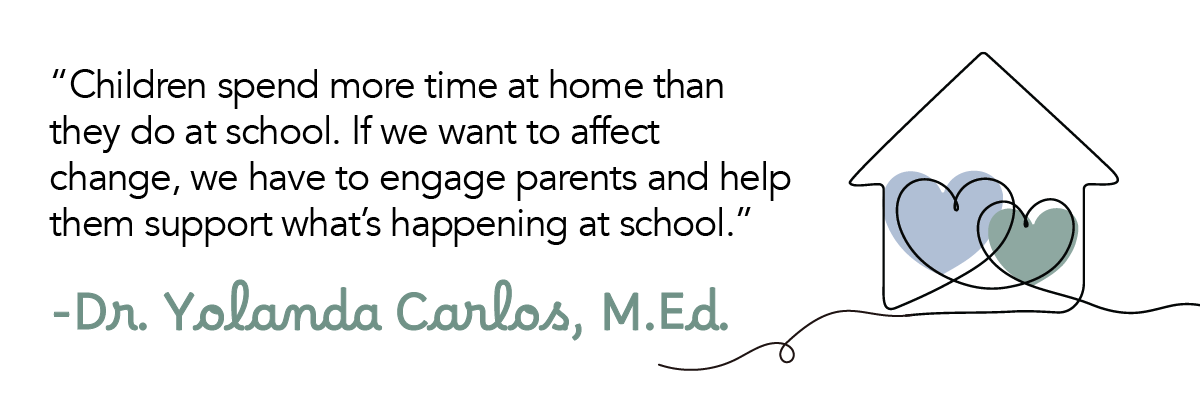By Matt Alderton
Like bicycles losing air from their tires, schools in the United States are losing students from their classrooms with an audible hiss. Public school enrollment fell from 50.6 million students in 2016 to 49.5 million in 2024, according to the National Center for Education Statistics (NCES). In the same period, the number of American children being homeschooled rose from 2.3 million to 3.7 million, the National Home Education Research Institute (NHERI) reports.
For many parents—nearly three-quarters of them, NCES says—at least one reason for homeschooling is their dissatisfaction with academic instruction at conventional schools. In fact, 55% of all parents say they’re currently dissatisfied with the quality of their kids’ K–12 education, finds a 2024 poll by Gallup.
The tension between parents and educators is often palpable, but a fundamental truth about which parents and teachers can agree is that child learners are more successful in school and in life when they have families who are actively engaged in their education.
The question for schools and communities, then, isn’t whether parents, guardians, and caregivers should be involved in kids’ education. Rather, it’s how involved they should be, and what educators can do to build collaborative teacher-parent partnerships that strengthen learning instead of constraining it.

The Power of Parental Involvement
Time and again, research has proven the merits of parental involvement in children’s education. Studies consistently find that students with involved parents experience higher academic achievement, school engagement, and motivation, including better grades and higher test scores, as well as higher rates of high school and college graduation. Students with engaged parents also have stronger cognitive development, higher self-esteem, fewer behavioral issues, and better social skills, research shows.
For these reasons and more, teachers want parents to be more involved with children’s learning. In fact, 84% of educators say they would choose to work at a school with more engaged parents over one that offers a higher salary, according to the National Association for Family, School, and Community Engagement (NAFSCE)

“When parents are involved in their children’s education, children thrive,” says Judy Krause, Ed.D., associate dean and program director for the Doctor of Education in Early Childhood Education program at Pacific Oaks College. “They do better. That’s the bottom line.”
The value of their presence is not lost on parents, adds Yolanda Carlos, M.Ed., an early childhood education lecturer and researcher at Pacific Oaks. “Children spend more time at home than they do at school,” Professor Carlos says. “If we want to affect change, we have to engage parents and help them support what’s happening at school.”
Building strong teacher-parent partnerships is easier said than done, though. While teachers overwhelmingly support parental involvement in early childhood education, nearly three-quarters of them acknowledge it’s challenging to engage parents in improving educational outcomes, NAFSCE reports.
It’s easy to understand why. While some parents are too involved in their kids’ education, others invariably are not involved enough. To be successful, teachers must be flexible and adaptable to help parents of all types and means find their way.

How Teachers Can Engage Parents
Due to factors such as culture, socioeconomic background, age, and grade level, the sweet spot for parent-teacher engagement might look different for every parent and for every teacher. The objective is always the same, however.
“The role of a parent is to help their children feel confident in formal learning settings,” Professor Carlos says. “That helps them master the skills of learning so they can then transfer those skills to other areas of their life as they grow older.”

Educators who want to help parents increase or optimize engagement with their child’s education should focus on a few key strategies, Dr. Krause and Professor Carlos agree:
1. Communication
To be engaged, parents must be informed. Communication, therefore, is foundational.
Along with open houses, back-to-school nights, and parent-teacher conferences, newsletters and notes home are tried-and-true ways of communicating with parents. But communication at its best flows both ways, according to Dr. Krause. “It’s all about building relationships, and you can’t build strong relationships with parents unless communication with families is a two-way street,” she says. “Have a way to communicate back and forth, like a notebook that you send home where the teacher writes some notes and then the parent writes some notes, or even just talking to each other on the phone.”
It can be easy for early childhood educators to fall into the trap of communicating with parents only when there are negatives to report, but teachers should take every opportunity to communicate positive messages as well. When teachers go out of their way to share students achievements and strengths, and to give parents and students compliments, it fills up their relationship bank with currency that they can spend when they need parents’ help overcoming challenges or obstacles.
“I used to send home note cards, like a postcard, letting parents know the positive things their student did that day,” Professor Carlos recalls. “You cannot believe how many calls I got from parents who appreciated that.”
2. Participation
Parents, children, and teachers all benefit when parents are active participants in their child’s education rather than passive observers, says Dr. Krause. Options might include volunteering weekly in the classroom, reading the occasional story to students, or being a chaperone on field trips. Dr. Krause acknowledges the difficulty working parents have to be available for such opportunities during weekdays, but she emphasizes that any amount of participation has value.
“Parents work, but they don’t necessarily have to be there physically in the classroom to be involved. There are little things they can do to help teachers that make a big difference,” Dr. Krause says. “It can be the simplest form of involvement.”
What’s important isn’t the time commitment or type of task. Rather, it’s the effort and commitment. Having a variety of opportunities available will allow even the busiest parents to feel connected to their child’s classroom.
Also critical to parental participation is at-home learning. “In the first five years, 90% of our brains are developing, so it’s really important that parents are involved at home, especially in early childhood,” Dr. Krause says. “That means talking, reading, singing—it can be so simple.”
3. Parental Confidence
Even the most competent parents will disengage from their children’s education if they don’t feel confident in their abilities as parents. For that reason, it’s important for teachers to build parents up in ways that reinforce positive parenting behaviors.
Meeting parents where they are—for example, by offering volunteer opportunities that are as accessible for single and working parents as they are for married and non-working parents—is one way educators can build parents’ self-esteem, according to Dr. Krause. “If I’m a single mom who’s working all the time, my confidence might be really low because I feel like I’m not able to be involved at my child’s school,” she says. “If my child’s teacher gives me ways to be involved that work with my schedule, that can help a lot.”
Public acknowledgements—for example, shoutouts in newsletters and at school events—are another great way to reward positive parenting behavior. “When my kids were little, they would have an awards ceremony for the children once a month, and at the end of the year, they gave out certificates to the parents who helped,” Dr. Krause recalls. “Recognizing parents for even the little things that they do to help their children succeed makes them feel appreciated and encourages them to continue those positive behaviors.”

Creating Parent-Ready Educators
Unfortunately, there are no national family engagement standards for educator preparation, according to NAFSCE, which says educator preparation programs in just 30% of U.S. states and territories train teachers in all four of what it calls the “four foundational elements of effective family engagement”: collaboration and partnership, communication, culture and diversity, and relationships and trust. That means that most educators in the United States enter classrooms without the necessary skills to engage parents in children’s learning.
Pacific Oaks College is an exception to the rule, according to Professor Carlos, who says Pacific Oaks faculty train students in all the aforementioned parent-engagement strategies. “In both our B.A. and M.A. Early Childhood Education degree programs, all of the coursework supports parent engagement,” she says. “We understand that children spend more time in the home than they do at school, so every course includes parent engagement frameworks and strategies to help motivate learners and their families.”
In particular, Pacific Oaks graduates are trained in the “Professional Standards and Competencies for Early Childhood Educators” published by the National Association for the Education of Young Children (NAEYC), which includes six professional standards and competencies that effective early childhood educators embody, one of which is “family-teacher partnerships and community connections.”

“I’ve heard many of our graduates say they were hired explicitly because they were able to discuss the NAEYC competencies and how they mastered those,” Professor Carlos says.
In addition to its degree programs in early childhood education, Pacific Oaks offers two credentialing programs, one in elementary education and another in elementary education and special education. Both of those also include coursework that addresses parent and family engagement, according to Dr. Krause. “We have several classes where parent involvement is a core component of the class,” she says. “Building relationships with families is the most important thing. That’s how you really get to know children, and getting to know children is how you reach them better.”

